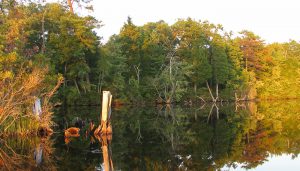Bordered by the megalopolises of New York City and Philadelphia, New Jersey is one of the smaller and more densely populated states in the United States. This notwithstanding, at least 40% of the State is still forested. New Jersey’s forests change gradually as one moves from the Pine Barrens on the Atlantic coastal plain to the western hill counties that merge with the Appalachian range. The Northern pitch pine occupies a prominent position in the pine forests. It is one of the few coniferous species that can develop new shoots on the trunk, thus rejuvenating itself when broken. Pitch pine wood is popular in Europe for mostly interior uses: it is used in flooring, paneling, doors, and furniture. In the eastern hardwood forests of New Jersey there are Pin oak and Scarlet oak, both species with leaves that have more deeply incised lobes than the well-known American oak. At the bottom of the arboretum group, at the meadow’s edge, we encounter some remarkable species. The tupelo tree exuberantly turns orange-red during the autumn. The sassafras, with its peculiar one-, two- or three-lobed leaves, is revered for its various pharmaceutical uses. The resident Persimmon tree entices us with rather strange fruits that, unfortunately, are not as big, sweet and palatable as those of its more fecund Asian brother, the Kaki.


